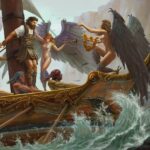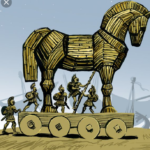The Pharaohs of Ancient Egypt were the rulers of one of the world’s most iconic civilizations. They were seen as living gods, who wielded immense power and authority over the people of Ancient Egypt. The Pharaohs were responsible for the construction of some of the most impressive architectural wonders of the world, such as the Pyramids of Giza, the Great Sphinx, and the temples of Luxor and Karnak. Their legacies continue to fascinate people all over the world and have left an indelible mark on human history.
The Pharaohs of Ancient Egypt were seen as living gods and were believed to be divine beings with a direct connection to the gods. They were responsible for the administration of justice, which included the establishment of laws and the punishment of those who broke them. The Pharaohs had the power of life and death over their subjects, and they could order the execution of anyone who they believed posed a threat to their rule.
The collection of taxes was another important responsibility of the Pharaohs. They oversaw the collection of taxes from the people of Egypt, which were used to fund public works such as the construction of temples, roads, and irrigation systems. The Pharaohs were also responsible for the defense of the kingdom, and they oversaw the construction of fortifications and the training of soldiers.
The Pharaohs were also the chief priests of the state religion and oversaw religious ceremonies and festivals. They were responsible for the worship of the gods and the performance of rituals that were believed to ensure the well-being of the kingdom. The Pharaohs were seen as the intermediaries between the gods and the people, and they were responsible for maintaining the balance between the physical and spiritual worlds.
The construction of temples and other public works was one of the most important responsibilities of the Pharaohs. They commissioned the construction of massive temples, such as the Temple of Luxor and the Temple of Karnak, which were adorned with intricate carvings and colorful paintings that depicted scenes from Ancient Egyptian mythology. The Pharaohs also commissioned the construction of massive tombs, such as the Pyramids of Giza, which were designed to ensure their safe passage to the afterlife.
Despite their divine authority, the rule of the Pharaohs was not without controversy. They were known to be ruthless in their treatment of dissenters and often used slave labor to build their monumental structures. However, the achievements of the Pharaohs in the areas of art, science, literature, and architecture have left a lasting legacy that continues to fascinate people all over the world.
One of the most famous Pharaohs was Tutankhamun. Tutankhamun, who is also known as King Tut, was a Pharaoh who ruled over Ancient Egypt for a very brief period, from 1332 to 1323 BCE. His reign was during the New Kingdom period, which was marked by great achievements in art, architecture, and technology. However, Tutankhamun is not known for any significant political or military achievements but is rather remembered today for the discovery of his tomb, which is one of the most remarkable archaeological finds in human history.
Tutankhamun’s tomb was discovered by British archaeologist Howard Carter in 1922. The tomb was located in the Valley of the Kings, which is a vast necropolis on the west bank of the Nile River in Luxor, Egypt. The discovery of the tomb was an international sensation and captured the world’s imagination with its treasures, which included a vast collection of golden objects, furniture, and other valuable artifacts.
The most famous object found in Tutankhamun’s tomb is the iconic golden mask, which is considered one of the most beautiful works of art from Ancient Egypt. The mask is made of solid gold and weighs over 22 pounds, and is adorned with precious stones and colored glass that make it shine in the light. The mask covers the face of Tutankhamun’s mummy and is thought to represent the Pharaoh’s idealized image in the afterlife.
Along with the mask, Tutankhamun’s tomb also contained other priceless treasures such as chariots, thrones, and jewelry, including bracelets, necklaces, and earrings. The tomb also contained canopic jars, which were used to store the Pharaoh’s internal organs after mummification. The jars were made of alabaster and were intricately carved and decorated.
The discovery of Tutankhamun’s tomb has provided a wealth of information about Ancient Egyptian culture and society. The tomb revealed much about the beliefs and practices of the Ancient Egyptians regarding death and the afterlife. It also showed the level of craftsmanship and artistry that the Ancient Egyptians had achieved, which is still admired and studied today.
Another notable Pharaoh was Ramses II. He was also known as Ramses the Great andnwas one of the most significant Pharaohs of Ancient Egypt, who reigned from 1279 to 1213 BCE during the New Kingdom period. He was the third Pharaoh of the Nineteenth Dynasty and was the son of Seti I. He is remembered today for his military campaigns, his construction of monumental buildings, and his diplomatic efforts.
Ramses II was a great military leader and is remembered for his campaigns against the Hittite Empire, which was one of the most powerful empires of the time. He fought in numerous battles and is known for his victory at the Battle of Kadesh, which was fought in 1274 BCE. Although the battle was not a decisive victory for either side, it was a significant event that resulted in a peace treaty between the two empires.
Ramses II was also known for his architectural achievements. He built numerous monumental buildings throughout Egypt, including the Ramesseum, which was his mortuary temple, and the Great Temple at Abu Simbel, which was one of the most impressive temples of the time. The Great Temple at Abu Simbel was carved out of a mountain and featured four giant statues of Ramses II, each of which stood at over 65 feet tall.
In addition to his military campaigns and architectural achievements, Ramses II was also a skilled diplomat. He signed the first peace treaty in recorded history with the Hittite Empire, which brought an end to a long-standing conflict. The treaty was significant because it marked the first time two empires had agreed to peace without one being subjugated by the other. The treaty was signed in 1258 BCE and was a significant achievement for Ramses II’s diplomacy.
Ramses II is also known for his family life. He had numerous wives and children, and his favorite wife was Nefertari. He built a temple for her, which was one of the most beautiful temples of the time. The temple featured impressive wall carvings and paintings, which depicted Nefertari and Ramses II in various poses.
The legacy of the Pharaohs can be seen in the many architectural marvels they built, including the Great Pyramids of Giza. These massive structures, which were built during the Old Kingdom period of Ancient Egypt, remain one of the Seven Wonders of the Ancient World. The Pyramids were built as tombs for the Pharaohs and were designed to ensure their safe passage to the afterlife. They were constructed using massive blocks of limestone and granite and are a testament to the skill and ingenuity of the Ancient Egyptians.
The Pharaohs were also responsible for the construction of numerous temples, such as the Temple of Luxor and the Temple of Karnak. These temples were built to honor the gods and were used for religious ceremonies and festivals. They were adorned with intricate carvings and colorful paintings, which depicted scenes from Ancient Egyptian mythology.
In addition to their architectural achievements, the Pharaohs made significant contributions to Ancient Egyptian culture and society. They commissioned works of art, such as sculptures, paintings, and jewelry, which are still admired for their beauty and craftsmanship. They also supported the development of science, mathematics, and medicine, which led to many important discoveries and innovations.
The Pharaohs of Ancient Egypt also left a lasting legacy in the field of literature. They commissioned scribes to write texts on a wide range of subjects, including religious, historical, and scientific topics. These texts include the Book of the Dead, a collection of spells and prayers designed to guide the deceased through the afterlife, and the Tale of Sinuhe, a story about an Egyptian official who flees to the land of Canaan.
Despite the achievements of the Pharaohs, their rule was not without controversy. They were known to be ruthless in their treatment of dissenters and often used slave labor to build their monumental structures. The power of the Pharaohs declined in the later periods of Ancient

![]()








GIPHY App Key not set. Please check settings